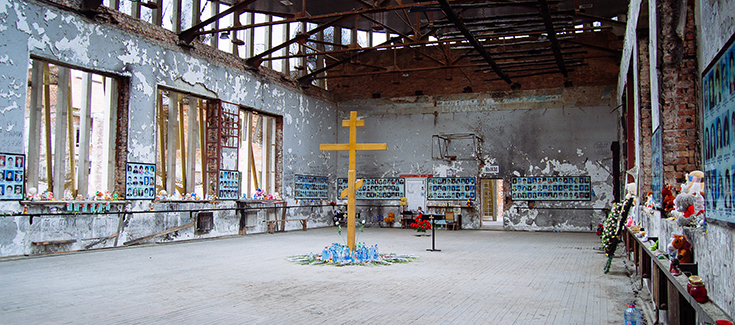Fifteen years after Beslan hostage tragedy, questions still remain
This year marks the 15th anniversary of the Beslan school hostage taking in North Ossetia, Alania (Russia), writes Advisor Panel Member Lina Kolesnikova. More than 1,000 hostages were held by terrorists for three days. The final death toll reached 356 people, including 318 hostages (168 of them children), two specialists from Emercom, one resident of Beslan, and ten Russian Special Forces operatives. officers of the Russian Special Forces.

Memorial to the victims of the Beslan siege in the sports hall where children and adults alike were subjected to brutal treatment and deprived of food and water (Nastya Tepikina / 123rf)
It is no exaggeration to say that the events of September 2004 in Beslan are the most dramatic in the history of modern Russia. They influenced all aspects of social, political and psychological life afterwards and brought back a memory of huge trauma, which was typical for all post Second World War generations in the Soviet Union.
The violent deaths of children and women were witnessed by millions of people in real-time because of television. This was the fourth mass hostage event in Russia after Budennovsk (1995), Kizlyar (1996) and Moscow (2002).
The attack in in Beslan aimed to fulfil several purposes for the terrorists. Of course, they wanted to threaten the Russian authorities and population, but they also wanted to provoke military conflict between the Ossetians and Ingush ethnic groups and create a new war in North Caucasus.
The terrorists used the same modus operandi as in Moscow in 2002 – hostages were kept in harsh conditions. Most of them were concentrated in the sports hall, sitting on the floor with a high density of people in one place. Hostages were not allowed to move or change body positions. Adults and children alike were beaten and insulted. On the first day men, who were considered by terrorists as capable of resisting, were executed and their bodies were left visible to others. Water and food supplies were stopped on the second day – as occurred during the Moscow siege – and hostages had to try to stay hydrated by drinking their own urine and sucking on the petals of plants and flowers.
Children were literally used as a live shield.
Mass hostage scenarios represent serious and seemingly intractable challenge to existing emergency response systems. Hostage-taking is among the most difficult type of terrorist attack to deal with, because they are so-called continuous emergencies.
During such events, response agencies have to deal with huge pressure from politicians and a conflict of aims is apparent: on the one hand, it is necessary not to follow the demands of terrorists (“we do not negotiate with terrorists”), but on the other, it is vital to save the lives of hostages at any price.
The topic of such responses spans terrorism, risk, crisis and disaster management, and raises multiple questions regarding how response management is working, how various involved agencies could work together, and so forth.
In this incident, bearing in mind the number of hostages, their age, their location in one large room, the absence of basements or underground tunnels – which could have been used by special forces to make an assault or use gas – it was necessary to carry on negotiations and use any chance possible to free as many children as they could.
Even 15 years later, there are still many questions left unanswered by official investigations. It is uncertain whether the explosion, which triggered the rescue operation, happened inside the school and was initiated by terrorists, or whether it was down to shooting from outside by the military, special forces or a local militia. Why was there a lack of preparedness as regards the attack, despite the fact that information about possible terrorist attacks was available and orders had been issued by the authorities requesting more protection be given to schools and other facilities?
Why did the Russian authorities repeatedly state there were 354 hostages inside the school for two days, but the list of people inside – which indicated more than 1,000 being held – had been drawn up a few hours after the event began?
There are many lessons to be learnt from the rescue operation in Beslan. Roughly speaking, these can be summed up into two areas – no proper perimeters were established (inner and outer) and the triage of victims was mismanaged.
There was nearly no organisation of the rescue operation, partially owing to the local population present on the scene. Hostages were not assigned identification, and local people were heavily involved in both firefighting and rescuing hostages. They took rescued hostages to various and randomly selected hospitals without any tracking – even though a special Emercom mobile hospital had been established nearby.
As a result, more than 200 people were thought to be missing for several weeks, leading to rumours that the terrorists escaped from the school and had taken some hostages with them.
This blog is a part of a book Dealing with mass hostage crisis: Crisis management framework, where all four cases of mass hostage events in Russia are thoroughly analysed.
The book is expected to be published at the beginning of 2020. If you have any questions regarding, please, feel free to contact CRJ or email Lina Kolesnikova
Read Lina's analysis of the Moscow Theatre siege of 2002 and Will Stewart's report on firefighting during the Beslan siege, from CRJ 1:1 (available to non subscribers at no charge)
Lina Kolesnikova, 17/10/2019